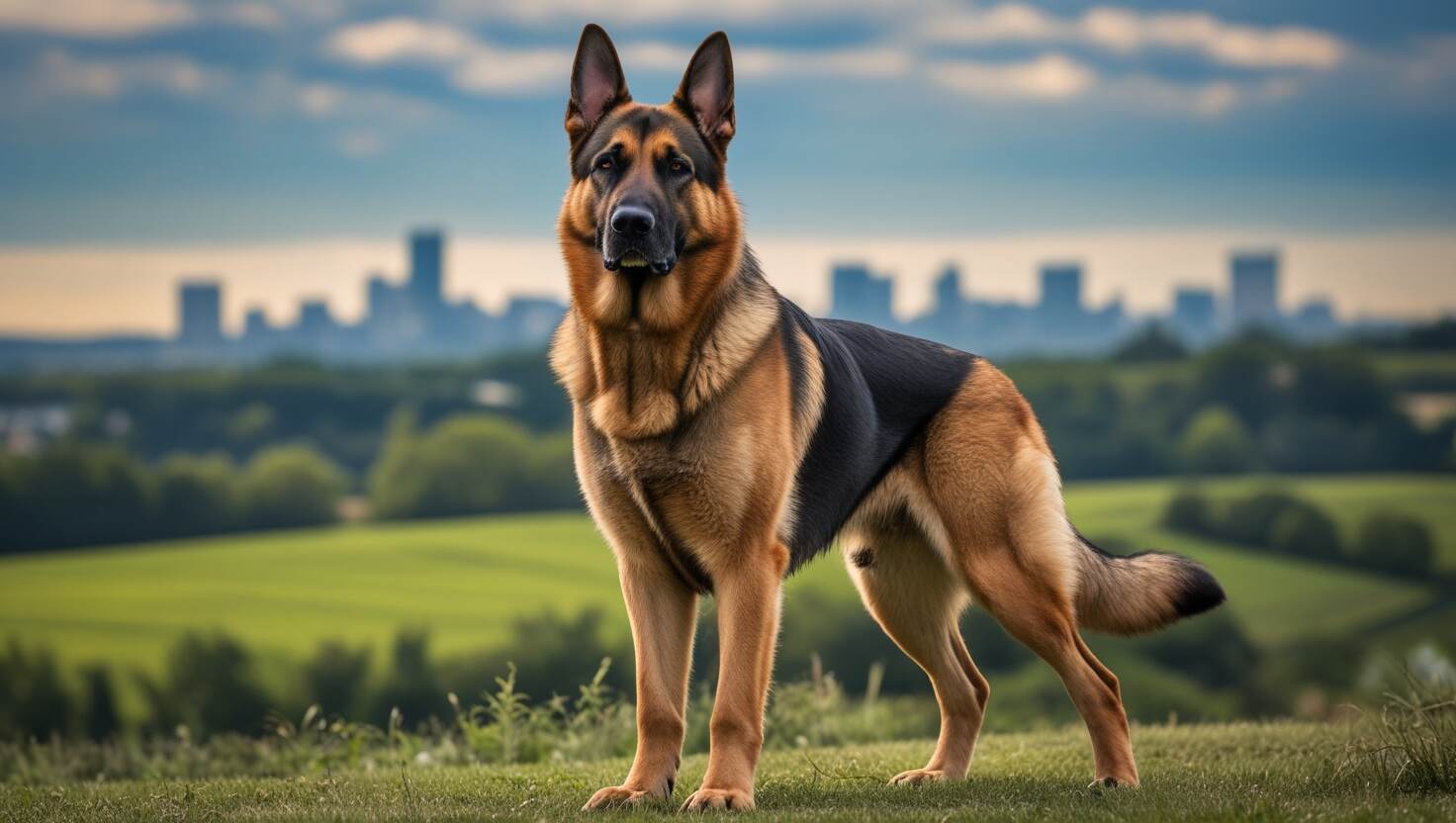German Shepherd
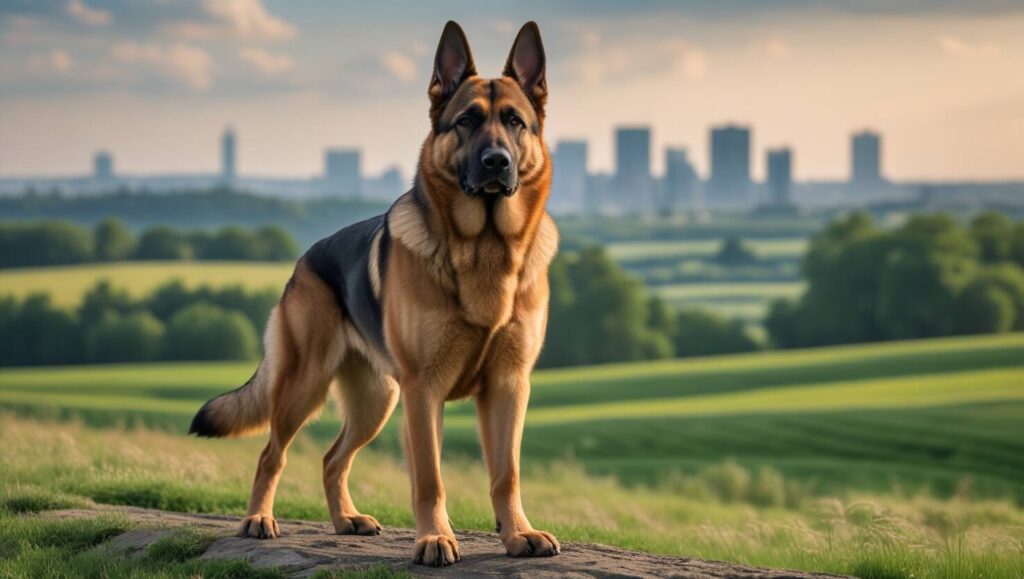
The German Shepherd is a highly intelligent, loyal, and versatile working dog originally bred for herding but now excels in police work, search-and-rescue, and as a family protector. Their agility, strength, and obedience make them one of the most respected breeds worldwide. Proper training, nutrition, and healthcare ensure a healthy and active life for this remarkable breed.
Introduction
The German Shepherd, also known as the Alsatian in the United Kingdom, is a medium to large size working dog that originated in Germany. Developed by Max von Stephanitz, this breed comes from traditional German herding dogs, originally used for herding sheep on farms. Over time, it evolved into one of dogkind’s finest all-purpose workers, excelling in police work, warfare, search-and-rescue, and disability assistance. Recognized by the Fédération Cynologique Internationale, it consistently ranks high in annual registrations.
This large, agile, muscular dog stands with noble character, moving with a smooth, graceful outline and a natural gait that allows a free-and-easy trot at great speeds. Its high intelligence, loyalty, confidence, and courageous nature make it a steadfast guardian and an exceptional companion dog. While gentle as family pets, they display certain aloofness, avoiding immediate, indiscriminate friendships, a defining trait of their breed standard.
Their ability to learn commands and tasks quickly places them at the front rank of canine royalty. Their willingness to put their life on the line for defense of loved ones is unmatched. As noted by Caroline Coile and other fact-checked Editors of Encyclopaedia Britannica, historical figures like Dorothy Leib Harrison Wood Eustis played key roles in shaping their role as guide dogs. Even today, stories in Newsweek showcase their intelligence, whether excelling in police work or even winning a Spaghetti Eating Competition!
Evolution of a Legendary Breed
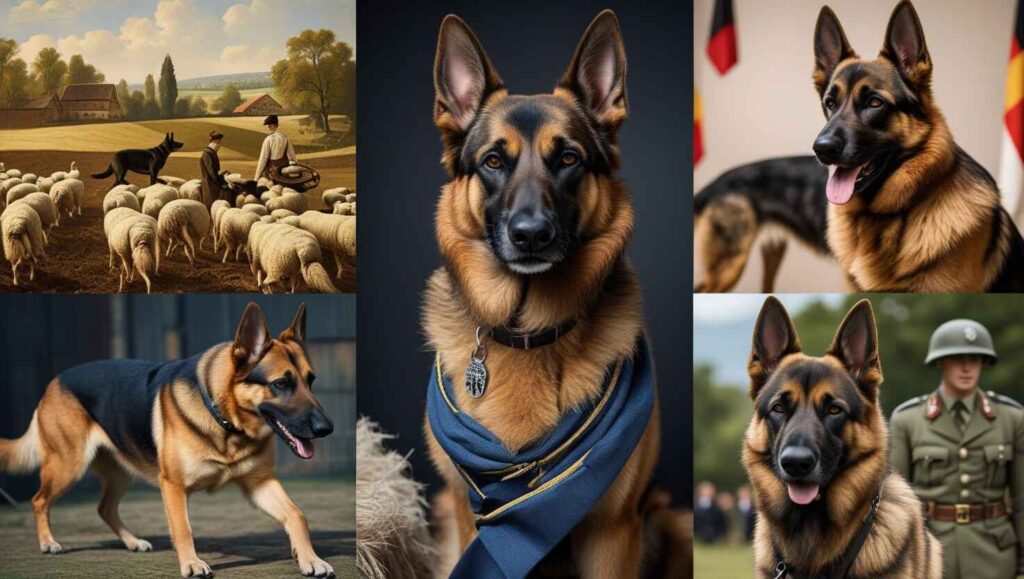
The German Shepherd, or Alsatian, has a rich history rooted in Germany. Originally bred for herding sheep and protecting flocks from predators, these dogs played a key role in local communities. Their intelligence, speed, strength, and a keen sense of smell made them highly efficient working dogs. The Phylax Society first attempted to standardise native dog breeds, but internal conflicts led to its failure. Later, Max von Stephanitz, a cavalry captain from Imperial Germany, pursued the standardised development of the breed, shaping its appearance and ability for working purposes.
At a dog show, he discovered Hektor Linksrhein, whose loyalty and beauty impressed him. Renaming him Horand von Grafrath, he founded the Verein für Deutsche Schäferhunde (Society for German Shepherd Dogs) and created the first breed register. Through selective breeding, the lineage of Heinz von Starkenburg, Beowulf, and Pilot established the breed’s versatility, agility, and authority. However, concerns about inbreeding also arose.
During Nazi Germany, the breed symbolized militarism and purity, with Adolf Hitler famously owning Prinz and Blondi. Their presence in propaganda and the Battle of Berlin reflected their status. After the Second World War, the breed faced bans in Australia and suspicion in the United States, where they were linked to gangsters and bootleggers. Despite challenges, their stealth and uncompromising leadership cemented their place in police and military roles. Even today, the Altdeutsche Schäferhunde, a traditional variation, remains popular in northern and central Germany.
Appearance & Characteristics
The German Shepherd is a medium to large-sized breed standard dog, known for its proportion—longer than tall with a well-balanced frame. Males typically stand taller at the withers than females, and both have a weight range suited for power and agility. They feature a domed forehead, square-cut muzzle, strong jaws, and a black nose. Their medium-sized brown eyes give them an intelligent expression, while their large erect ears remain alert. Their long neck is raised when excited and lowered when moving, especially when stalking at sprinting speeds.
Built for movement, they have an open front, parallel legs, and a bushy tail that reaches the hock. Their double coat includes a dense, thick undercoat and a medium coat, with a rarer long-haired variety due to a recessive gene. Recognized by the German Kennel Club, UK Kennel Club, and FCI, acceptable colors include tan/black, red/black, sable, and pure-black, while panda, silver, liver, and blue are considered serious faults or may lead to disqualification in All Breed Shows and Specialty Shows. Bred for intelligence, strength, police, guard, and search-and-rescue work, they quickly learn tasks and interpret instructions with ease.
Training & Exercise
The German Shepherd is an intelligent, adaptable dog that thrives on early socialization and puppy training. Proper obedience training helps them grow into well-mannered companions and workers. Using consistency, positive training, and reward-based training, owners can keep them bonded with the family and household. Engaging them in family activities strengthens their role as loyal protectors.
Their active, athletic nature means they need plenty of exercise for physical well-being and mental well-being. Without it, they may develop frustration and undesirable behaviors. Daily walks, play sessions, and a fenced area for free movement help maintain balance. A leash is essential when outdoors to keep them from getting distracted.
For additional engagement, canine activities like agility, herding, tracking, and dock diving provide a rewarding experience. A dedicated owner will find training this breed both fulfilling and effective.
German Shepherd: Ensuring a Healthy and Active Life
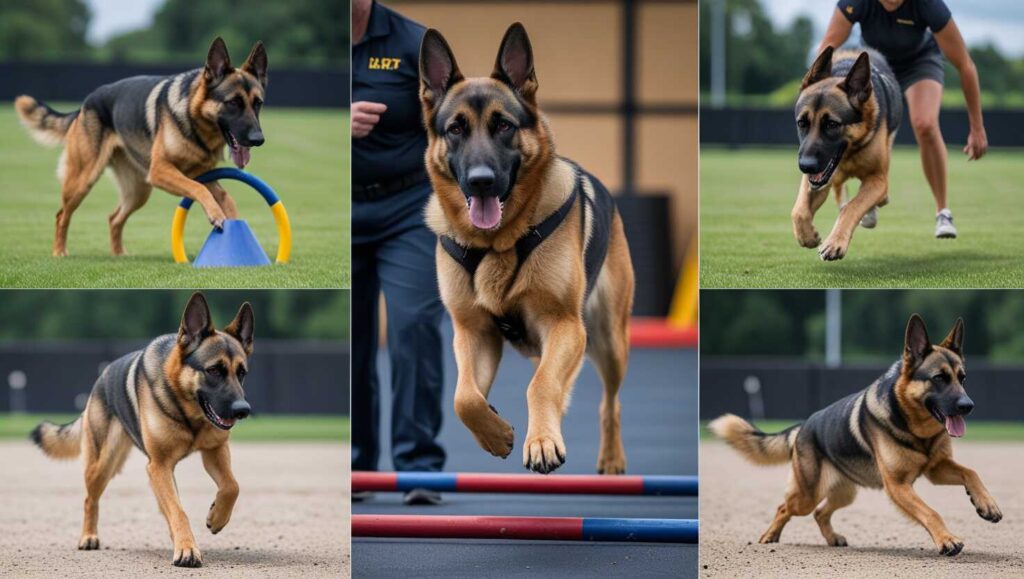
Common Genetic and Musculoskeletal Disorders
The German Shepherd is prone to genetic disorders due to inbreeding, leading to conditions like hip dysplasia, elbow dysplasia, arthritis, and degenerative spinal stenosis. These musculoskeletal disorders can cause lameness, inflammation, joint disease, and pain. Severe cases may result in Cauda equina syndrome or osteoarthritis, requiring joint supplements, anti-inflammatory medications, or surgery. Pituitary dwarfism, caused by a genetic mutation, leads to growth retardation and alopecia, as studied by the University of Utrecht.
Digestive, Heart, and Cancer Risks
Digestive issues such as bloat or gastric dilation-volvulus can cause a distended stomach, dry heaving, abdominal pain, and collapse. This condition leads to gas pressure, breathing difficulties, and shock, often requiring emergency gastropexy to prevent stomach rupture. Exocrine pancreatic insufficiency, affecting the pancreas, leads to ravenous appetite, soft stools, belching, and excessive gas, treatable with enzyme supplements. Von Willebrand disease, a bleeding disorder, can cause excessive bleeding from minor injuries. Cancer is another major concern, with hemangiosarcoma, bone cancer, lung cancer, and intestinal cancer being common. Treatment may involve chemotherapy, radiation, surgery, or palliative care. Heart disease, including dilated cardiomyopathy, valvular disease, heart murmurs, and arrhythmias, affects blood flow. Managing sodium intake and ensuring proper amino acids in their diet supports heart health.
Skin, Coat, and Exercise Needs
Pannus or keratitis, worsened by UV light exposure and air pollution, may require dog goggles for protection. Their double coat needs regular brushing to prevent shedding, itching, fur loss, and odours. Proper bathing and nutrition with large-breed puppy food promote a slower growth rate, reducing joint instability. Warm weather and cold weather care are essential for their well-being. Routine health tests, hip evaluation, and temperament tests are crucial for long-term health. Frequent exercise, agility, tracking, protection work, and awareness of fence height prevent injuries. Being strong swimmers and retrievers, they enjoy water-based activities, which help maintain their physical and mental health.
Related Article : Do German Shepherds Shed?
German Shepherd: Proper Nutrition for a Healthy Life

Balanced Diet and Feeding Routine
A German Shepherd requires a high-quality dog food that meets its nutritional needs at different life stages. An age-appropriate diet is crucial, with puppies needing a large-breed formulation to support growth and prevent obesity. Switching to adult food should happen around 12–18 months, and seniors may need specialized nutrition for joint and digestive health. Avoid table scraps, cooked bones, and high fat content, as these can cause digestive upset and pancreatitis. Healthy options include yogurt, cooked vegetables, eggs, and other safe human foods in moderation. A vet consultation ensures the diet follows established standards set by the Association of American Feed Control Officials.
Feeding Schedule and Preventing Health Issues
To reduce the GDV risk (gastric dilation-volvulus), feeding should align with a consistent schedule—three to four times per day for puppies and twice a day for adults. Smaller frequent meals help prevent bloating, especially when combined with proper exercise timing. Training treats should be used wisely to avoid excessive weight gain. If needed, mineral supplements and vitamins can support overall health, but only under veterinarian guidance. Proper weight management and a diet suited to their lifestyle will keep them active and healthy for years.
German Shepherd: Grooming and Maintenance for a Healthy Coat
Coat Care and Shedding Control
The German Shepherd has a medium-length coat with a double coat, consisting of a dense outer coat that is harsh and close-lying and a soft undercoat for insulation. While they require easy maintenance, frequent brushing is necessary to manage loose hairs and reduce shedding, especially during high-shedding periods in spring and fall when they are blowing coat. Using the right dog brushes helps with undercoat management and keeps natural oils balanced. While an occasional bath with shampoo for dogs is good for coat maintenance, excessive bathing can strip essential oils, leading to skin problems. Their coat colors vary from black and tan, all-black, black and red, black and cream, black and silver to rare shades like white, liver, and gray.
Eye, Ear, and Nail Care
Regular eye care is essential, especially in high-altitude areas where UV rays can impact vision monitoring. Their ears need proper ear care, including ear cleaning to prevent bacterial growth and ear infection. Using a suitable ear cleaner helps maintain healthy ears. Nail care is equally important—regular trims prevent overgrown nails, which can cause breaking nails and structural issues. Ensuring proper at-home care and monitoring their skin care will keep them comfortable and healthy.
German Shepherd: Controversies and Concerns
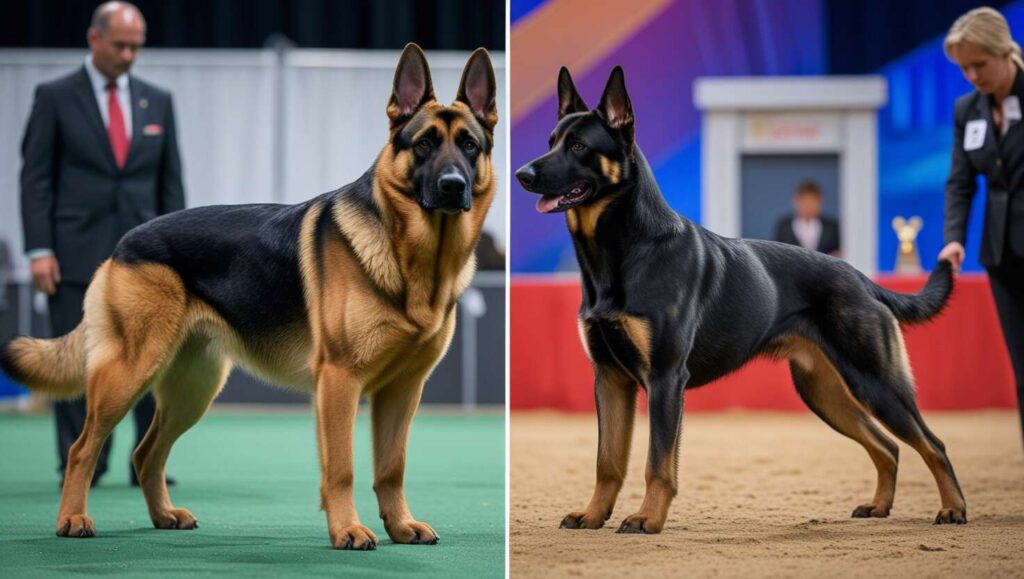
Breeding Challenges and Structural Issues
The modern breed of German Shepherd has faced criticism for its deviation from the vision of Max von Stephanitz, who focused on working dogs with strong intelligence and working ability. Over time, some breeders prioritized appearance over function, leading to controversy in the Kennel Club (United Kingdom) and other breed clubs. The development of a show strain with a roached topline, poor gait, and exaggerated hind legs sparked debates about soundness. A BBC documentary, Pedigree Dogs Exposed, highlighted concerns, with critics calling these dogs “half dog, half frog” due to their abnormal gait. An orthopedic vet noted how these changes caused movement issues, leading to calls for judge retraining and penalization of extreme features.
Health Problems and Ethical Concerns
Despite efforts in breeding control to eliminate defects, certain genetic conditions persist. Haemophilia and hip dysplasia remain significant concerns, affecting mobility and quality of life. Ethical breeding practices and health testing are essential to maintaining the essential conformation of the breed. While some argue that beauty should not outweigh function, responsible breeders focus on balancing both traits to ensure a healthier future for the German Shepherd.
German Shepherd: Frequently Asked Questions
Is German Shepherds Good With Kids?
Yes, the German Shepherd is a loyal and protective family dog. With proper training and socialization, they are good with kids and enjoy engaging with children. However, they need an active lifestyle to stay happy and mentally stimulated. As one of the smartest dog breeds, they are easy to train for both home and work settings. Their lifespan is around 7–10 years, and they require regular care, especially due to heavy shedding. They shed year-round, with a blowing coat occurring in fall and spring, making routine brushing essential to keep their coat healthy.
Related Article : Are German Shepherds Good With Kids?
What Makes the German Shepherd Unique?
The German Shepherd is famous for its intelligence and versatility as a working dog. They are often compared to the Belgian Malinois, but they are separate breeds with a size difference—German Shepherds weigh 50–90 pounds, while the Belgian Malinois is lighter at 40–80 pounds. Some German Shepherd mixes have longer fur, affecting grooming needs. They enjoy swimming, so many German Shepherds like water. Their price range varies depending on a reputable breeder, but adoption from local shelters and rescues is a great option.
Kindly note: The content shared in this blog is gathered from online sources, some of which may not be verified. For accurate guidance on caring for your dog, it is recommended to seek advice from a qualified veterinarian.

